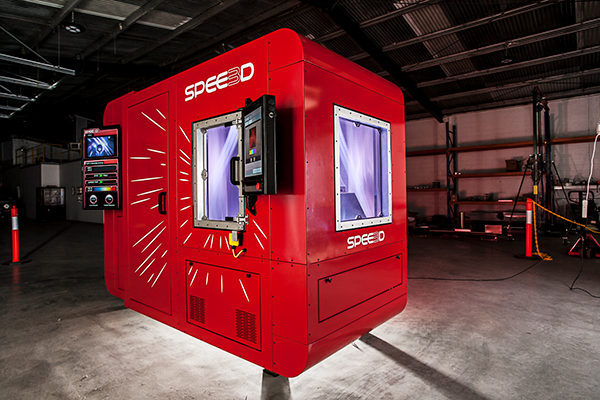Penn State Buys SPEE3D Metal 3D Printing Technology
Penn State University have acquired SPEE3D’s high-speed metal 3D printing technology, bringing new research and development opportunities to additive manufacturing in the U.S.

The metal 3D printers from SPEE3D leverage cold spray technology, which can produce industrial quality metal parts in just minutes, rather than days or weeks. Image courtesy of SPEE3D.
Latest News
June 24, 2021
Penn State University’s latest investment into a LightSPEE3D Cold Spray metal 3D printer will allow the institution to advance its Additive Manufacturing (AM) capability. The Applied Research Laboratory adopting SPEE3D’s high-speed metal 3D printing technology as the latest tool for new research and development opportunities in the U.S.
“Our collaboration with SPEE3D is an excellent addition to our current capabilities in Metal Additive Manufacturing and Cold Spray. We are looking forward to developing and applying SPEE3D technology to meet the materials and manufacturing challenges of the US Navy, DoD and the industrial base,” says Tim Eden, Ph.D., head of the Material Science Division at The Applied Research Laboratory at Penn State University and Professor of Engineering Science and Mechanics.
SPEE3D’s high-tech metal 3D printers run at a supersonic speed 100 to 1,000 times faster than traditional metal 3D printing methods, according to the company. The metal 3D printers leverage cold spray technology, which can produce industrial quality metal parts in just minutes, rather than days or weeks.
Through SPEE3D’s recent Australian Army field trials, it is also a deployable metal 3D printing technology. The company’s LightSPEE3D and WarpSPEE3D machines can operate in austere environments such as the field of combat, on base, or at sea, making them a solution for building components on demand at the point of need.
Eden, alongside Janice Bryant of the Naval Sea Systems Command (NAVSEA) Technology Office, will use the technology at Penn State University to conduct research into the advancement and development of additive manufacturing equipment within the U.S.
“NAVSEA is excited about the potential of SPEE3D technology to bridge the gap between cold spray and metal additive manufacturing,” adds Janice Bryant, Expeditionary and Sustainment Technology manager. The Naval Sea Systems Command (NAVSEA) Technology Office champions the timely transition of emerging technologies into ships, submarines and the communities that design, build and maintain them—resulting in a more affordable and capable Fleet.
The Applied Research Laboratory of Penn State University is a Department of Defense designated University Research Center. Its purpose is to conduct essential research, developments and systems engineering in support of the nation’s priorities. For over 70 years, it has offered advanced research and development services to America’s Defense, industry and education communities. Developed in Australia, SPEE3D’s printer technology at Penn State University provides the institution the capability to expand their field of research and deliver real-world additive manufacturing solutions to industry stakeholders.
“Having our LightSPEE3D metal 3D printer at Penn State University’s Applied Research Laboratory is quite exciting for SPEE3D. This partnership will no doubt allow the institution to develop leading research within the field, enabling them to work at the forefront of the industry,” states Byron Kennedy, CEO of SPEE3D.
More information on SPEE3D’s technology, including videos and case studies are available here.
Sources: Press materials received from the company and additional information gleaned from the company’s website.
Subscribe to our FREE magazine, FREE email newsletters or both!
Latest News
About the Author
DE’s editors contribute news and new product announcements to Digital Engineering.
Press releases may be sent to them via [email protected].






